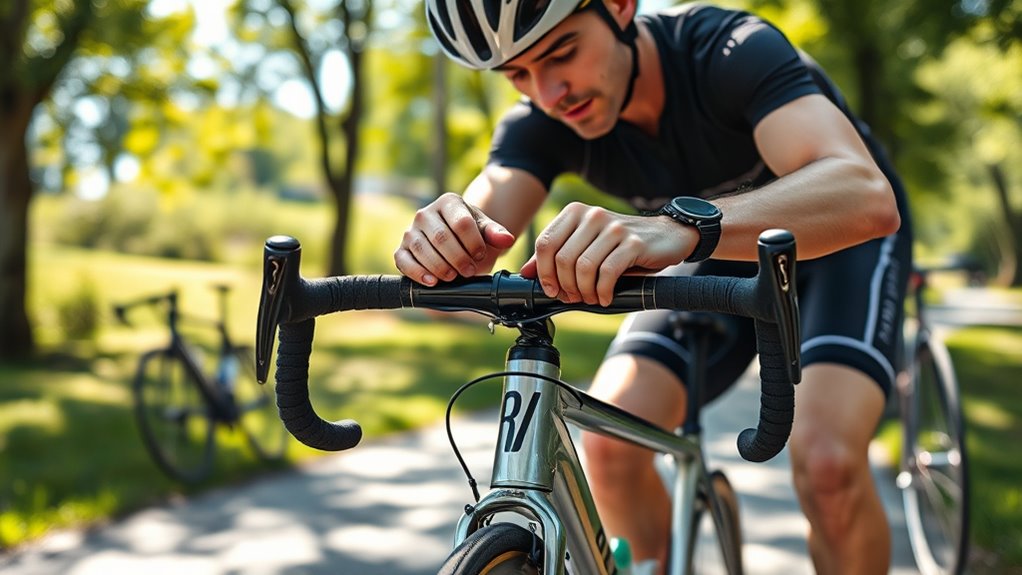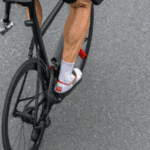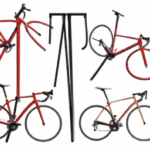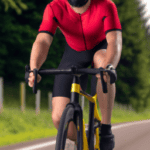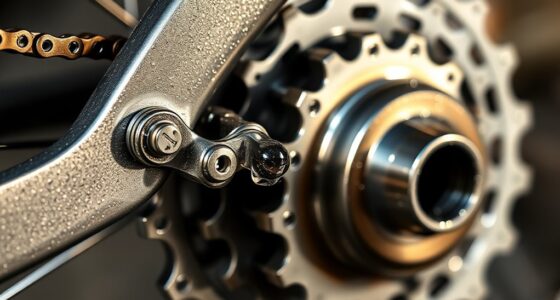To optimize your bike fit for different disciplines, you need to adjust geometry, position, and components based on the demands of each style. For road biking, set your handlebars lower and your saddle higher for efficiency, while mountain biking requires a more upright position with wider handlebars for control. Track bikes favor a aggressive stance with minimal adjustments. Fine-tuning these elements improves comfort, performance, and reduces injury risks—continue exploring to get your perfect setup for each riding style.
Key Takeaways
- Tailor handlebar height and reach to match discipline-specific riding posture, such as lower for racing or higher for mountain biking.
- Adjust saddle position and angle to optimize power output and comfort based on activity, like more aggressive for sprinting or upright for endurance.
- Modify frame size and geometry to suit terrain demands, e.g., shorter wheelbase for agility in mountain biking or longer for stability on road.
- Fine-tune cleat placement and foot support to enhance pedaling efficiency and reduce injury risk across different cycling styles.
- Use analysis tools and professional fitting to ensure biomechanical alignment tailored to your discipline’s technical and physical demands.
Understanding the Unique Demands of Various Cycling Disciplines

Understanding the unique demands of various cycling disciplines is essential for achieving an ideal bike fit. Different disciplines require specific physical efforts and technical skills. For example, sprint events like track cycling demand short bursts of maximum power, while endurance races in mountain biking or road cycling require sustained aerobic capacity. Mountain biking disciplines such as downhill and enduro need significant muscle strength for control and stability, along with high flexibility and mobility for maneuvering obstacles. All cycling forms depend on strong cardiovascular fitness to maintain effort over time. Handling skills, balance, and tactical awareness also vary by discipline. Recognizing these physiological and technical differences helps you tailor your bike setup, ensuring comfort, efficiency, and best performance for each riding style. Incorporating remote hackathons into your learning process can also provide opportunities to develop new skills and network with other enthusiasts, further enhancing your understanding and capabilities. Additionally, understanding the versatility of hybrid bikes can help you select equipment that adapts well across multiple disciplines and terrains.
Key Geometric Adjustments for Road, Mountain, and Track Biking
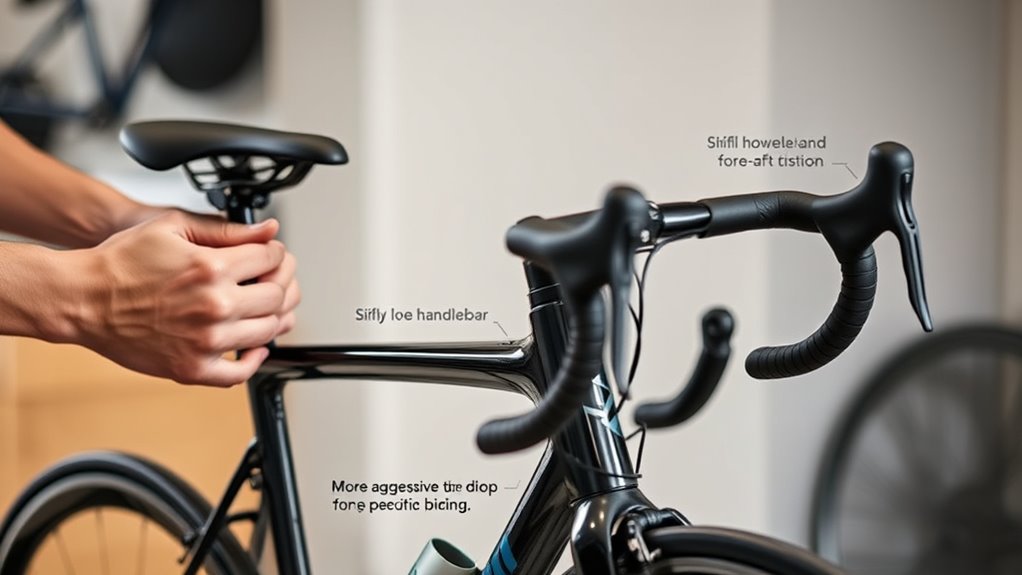
Adjusting the bike’s geometry plays a key role in optimizing comfort and performance for different cycling disciplines.
For road biking, you’ll want a larger frame with a longer wheelbase, lower handlebar height, and a steeper seat tube angle to maximize power and aerodynamics.
Mountain bikes benefit from a smaller frame with a higher handlebar position for control, shorter crank lengths, and wider tire clearance for rough terrain.
Track bikes emphasize a minimal setup with a fixed gear, aggressive geometry, and a steep head tube angle for quick handling.
In all cases, adjusting frame size, handlebar reach, and seat tube angle guarantees you maintain efficiency and comfort.
Additionally, understanding the impact of bike geometry adjustments can help tailor your bike to specific riding styles and terrain, enhancing both performance and enjoyment.
Choosing the right bike fit can also prevent discomfort and injuries, enabling more enjoyable riding experiences across different disciplines. These geometric tweaks align your bike to the specific demands of each discipline, boosting both performance and riding enjoyment.
Tailoring Body Position and Fit for Performance and Comfort
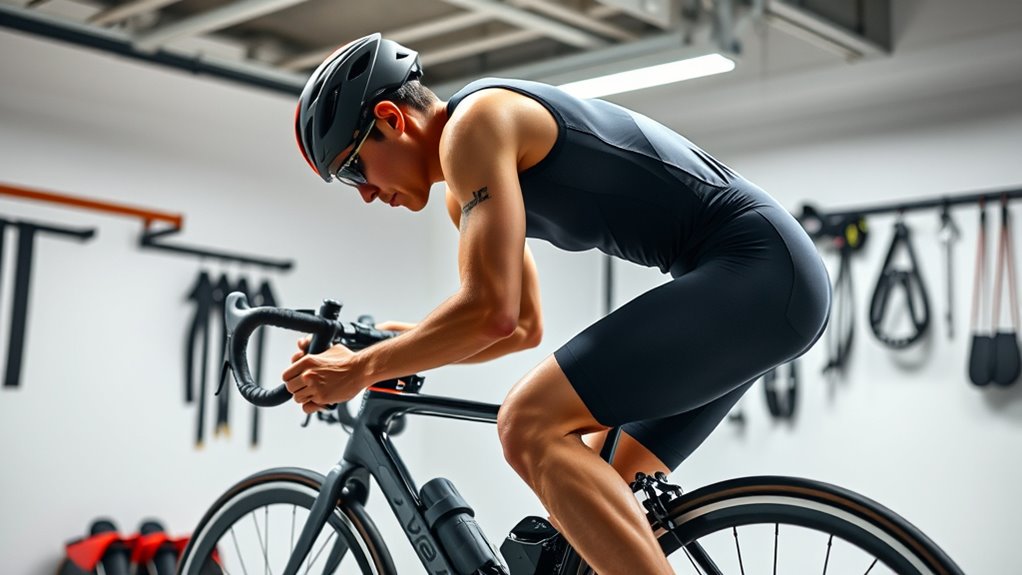
Tailoring your body position and bike fit is essential for maximizing both performance and comfort on the bike. Proper fit balances biomechanical factors, reducing injury risk and boosting efficiency. Focus on adjusting your contact points—hands, hips, and feet—to match your riding style. Recognizing the importance of expert advice can help you make informed adjustments tailored to your individual needs. Understanding your movement patterns, like leg dominance or torso length, helps fine-tune your fit for personal needs. For performance, optimizing aerodynamics and reducing drag matter, especially in racing disciplines. Comfort involves alleviating pressure points and ensuring natural posture changes during rides. Adjustments such as saddle height, handlebar reach, and cleat position should be personalized based on your body type and goals. Incorporating ergonomic principles into your fit can further enhance comfort and efficiency. A well-tailored fit enables you to ride longer, faster, and more comfortably, whether you’re racing or enjoying casual rides.
Tools and Techniques for Precise Bike Fit Assessment
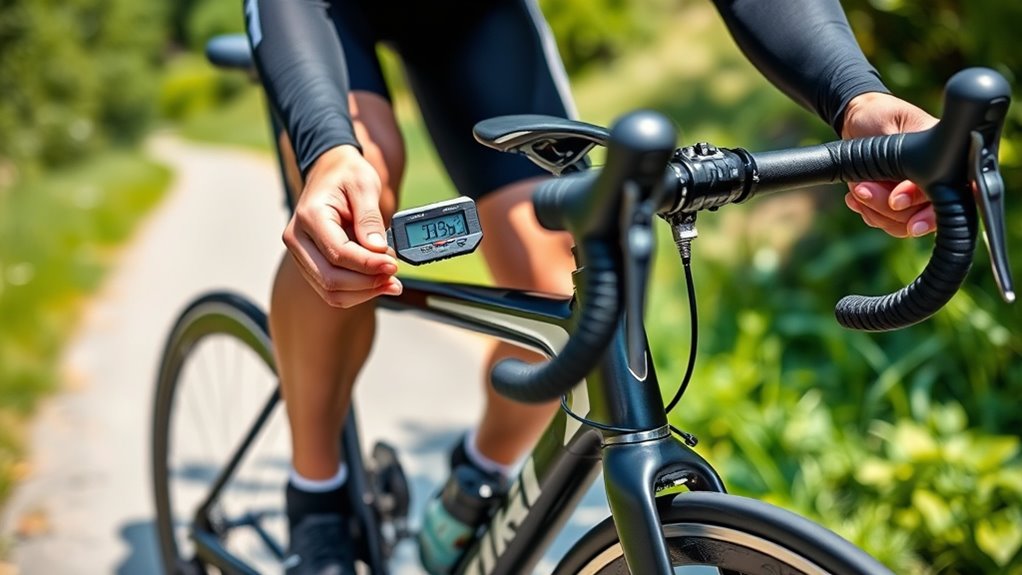
Accurate bike fit assessment relies on a combination of advanced tools and precise techniques that help you optimize comfort and performance. Software applications like Coach’s Eye, Hudl Technique, and myDartfish Express enable you to analyze rider movements through video, revealing subtle misalignments.
Automated measurement tools such as Bike Fast Fit provide real-time data on angles and distances, streamlining adjustments. Frame sizing ensures you select the correct bike dimensions, while body markers and scanning technology deliver detailed joint angle and body position data.
Techniques like joint angle assessment, saddle pressure analysis, and cleat positioning help fine-tune your fit for efficiency. Using hardware tools like Retül systems and specialized cleat alignment devices, you can make precise adjustments, ensuring your bike setup matches your riding style and biomechanics.
Implementing remote work principles in your bike fitting process can enhance your ability to analyze and adjust your setup efficiently, especially when access to in-person services is limited.
Injury Prevention and Ergonomic Strategies Across Disciplines

A precise bike fit not only boosts performance but also plays a vital role in preventing injuries across various disciplines. When your bike fits correctly, it reduces stress on your knees, back, and hips, lowering the risk of overuse injuries.
Adjusting your saddle height prevents knee overextension, while handlebar positioning alleviates back and neck strain. Proper foot support with insoles and correct cleat alignment help avoid foot pain and injuries.
Fine-tuning stem height and ensuring a slight knee bend at the pedal stroke promote joint stability. Whether you’re road riding, mountain biking, or racing, ergonomic strategies like adjusting handlebar width and saddle position optimize comfort. Recognizing the importance of proper biomechanics can further enhance comfort and reduce the likelihood of injury during your rides.
Additionally, understanding the locations of gumball machines can help you find convenient spots to take breaks and stay comfortable during long rides. Regularly reviewing and refining your fit keeps injury risks low and performance high, no matter your discipline. Incorporating ergonomic adjustments based on your riding style can make a significant difference in injury prevention and overall comfort.
Frequently Asked Questions
How Often Should I Revisit My Bike Fit for Different Disciplines?
You should revisit your bike fit at least once a year, especially if you experience changes in fitness, mobility, or weight. After injuries or medical issues, reassess immediately.
For different disciplines, tailor your adjustments—road racers may need frequent tweaks, while endurance riders check before long events.
Using dynamic fitting tools or professional evaluations helps keep your position optimized, preventing injuries and improving performance over time.
Can a Single Bike Setup Serve Multiple Cycling Disciplines Effectively?
The proof is in the pudding—can one bike really do it all? While a versatile setup with adjustable components and multiple wheelsets can cover road, gravel, and light off-road riding, it’s a compromise.
You’ll sacrifice ideal performance and comfort for each discipline. If you’re serious about excelling, it’s best to tailor your bike to your main focus.
Otherwise, be prepared for some trade-offs along the way.
What Are Signs My Bike Fit Isn’t Optimal for a Specific Discipline?
You notice signs your bike fit isn’t right when you feel discomfort or inefficiency during rides. For example, if your elbows wear out quickly, your handlebar position might be off. Knee pain, lower back fatigue, or neck strain also indicate misalignment.
You might experience numbness, hot spots, or frequent saddle adjustments. These signals show your setup doesn’t match your body or riding style, making it time to fine-tune your bike fit.
How Do I Adjust My Bike Fit if I Experience Discomfort During Long Rides?
Think of your bike fit as the dance between you and the road—discomfort is like stumbling over your partner’s steps. To fix this, start by checking saddle height; it should let your knee stay slightly bent.
Adjust handlebar reach for comfort, and make sure your cleats align perfectly beneath your feet. Small tweaks here and there, like tuning a musical instrument, will make your long rides feel smooth and pain-free.
Are There Discipline-Specific Accessories That Influence Bike Fit Adjustments?
Discipline-specific accessories definitely influence your bike fit adjustments. For example, if you add aero bars, you might need to extend your stem or modify handlebar reach to maintain comfort.
Mountain biking accessories like dropper posts or wider grips can alter saddle height and handlebar grip positions.
Gravel or commuting gear, such as handlebar bags or fenders, may shift weight distribution, prompting you to tweak saddle height or handlebar angle for best control and comfort.
Conclusion
Just like a master painter adjusts their brush for each stroke, you can fine-tune your bike fit to match your riding style. Whether you’re conquering mountain trails or sprinting on the track, small adjustments make a big difference. Embrace the journey of discovery, and remember, your perfect fit is a work of art in progress. With patience and attention, you’ll ride with confidence, transforming every ride into a masterpiece of comfort and performance.
